July 26, Greenland

Dramatic discovery Confirms Scientists' Predictions of Accelerated Global Warming
East Coast Greenland - Independent scientists on board the Greenpeace ship Arctic Sunrise recently discovered that a Greenland glacier has accelerated in the past 9 years exceeding all expectations and has now become one of the fastest moving glaciers in the world. These observations validate predictions about impacts to Greenland glaciers from recent global warming.
Outlet glaciers like Kangerdlugssuaq transport ice from the heart of the Greenland Ice Sheet to the ocean and discharge icebergs, which contribute to sea level rise. Kangerdlugssuaq Glacier alone transports or "drains" four percent of the ice from the Greenland Ice Sheet, and so any changes in the speed of these glaciers holds tremendous significance in terms of sea level rise.
"This is a dramatic discovery," said Dr. Gordon Hamilton, who undertook the measurements on Kangerdlugssuaq Glacier on Greenland's east coast with University of Maine PhD student Leigh Stearns. "There is concern that the acceleration of this and similar glaciers and the associated discharge of ice is not described in current ice sheet models of the effects of climate change. These new results suggest that the loss of ice from the Greenland Ice Sheet, unless balanced by an equivalent increase in snowfall, could be larger and faster than previously estimated."
The Arctic Sunrise is in Greenland this summer documenting the signs and impacts of global warming in this part of the Arctic. The scientists from the Climate Change Institute at the University of Maine are conducting an independently-funded study into glacier variations as evidence of recent global warming.
July 21, Greenland
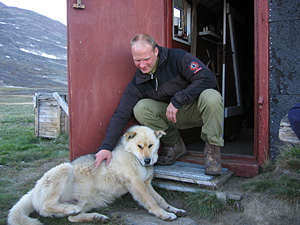
The One World team is definitely not idle. Lonnie is in California for several speaking engagements and to talk more about Global Warming and Eric is in Wisconsin on a similar mission. Meanwhile, John Hoelscher visits his old Greenland friends.
John writes: We are now in Kangerlusuaq Fjord,
doing glaciology. I took five others roped up for glacier travel last night, and we walked on a rugged glacier checking out crevasses for about 3 hours - was quite a buzz. Should leave in about 24 hours.
On venturing ashore to visit the rustic Zackenberg hunting hut, established by the Nanoq trading company in 1930, I had the fortune of meeting one of the twelve members of the Sirius Sledge Patrol team, Jesper Christensen. He was nearing the end of his two-year tour at Daneborg, the headquarters of this Danish Military outpost, which has been in operation since 1950. Its primary purpose is to maintain a military presence and patrol an area of 160,000 square kilometers, the world's largest national park.
Before the Sirius Patrol was established with the advent of the Cold War, the Greenland Sledge Patrol, made up from East Greenland civilian hunters, operated during WW2, with the task of patrolling the eastern coastline to look for secret German weather stations set up to forecast the weather, necessary for scheduling bombing raids on allied targets across the UK. In fact, there was one famous encounter near Eskimoness, Clavering Island, where the party did chance upon the German soldiers.
July 12, GM, DC and Greenland
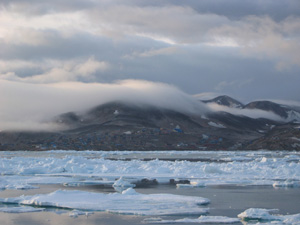
Sure it's 85 degrees and as hot as it ever gets in Grand Marais, but that isn't stopping us from thinking about the future. On July 18, 2006 OWE will make another summer attempt at crossing the ocean's broken sea ice from the North Pole to Cape Morris Jessup, Greenland.
The 50-day expedition will cover 540 miles pulling 160-pound modified whitewater canoes. We expect to reach landfall by September 5th, the last day of 24 hours light and the start of fall storms and precipitation. The route was picked due to favorable southerly drift of the sea ice.
The team will be flown to the expedition's start at the North Pole by Russian helicopter out of Norway's Spitzbergen Island. At Cape Morris Jessup, Greenland's northernmost land and expedition's finish, the team will be picked up by Twin Otter aircraft and flown back to Canada or Iceland then home.
John Hoelscher sends this message: We arrived at the anchorage in front of the East Greenland town of Ittoqqortoormiit (Scoresbysund), located near the northern entrance to Scoresby Sound - the world's largest fjord complex, around midnight. This isolated town of around 550 people was established in 1925 when families from the Ammassalik District, around 700 km south, were brought north to this location. It was known that it was rich in marine life and food for the people who traditionally catch seals, walrus and polar bears. Also on the land in the fjord system muskoxen can be found grazing on the grasses and lichen.
Ann reports from Washington D.C.: I'm also involved in the ship tour the Arctic Sunrise will be making down the east coast of the U.S. in early September, working with communities in Massachusetts and New York to promote and implement cleaner, climate-friendly forms of energy such as offshore wind. Stay tuned for more details on this leg of the tour, or check the Project Thin Ice Web site
July 5, East Greenland
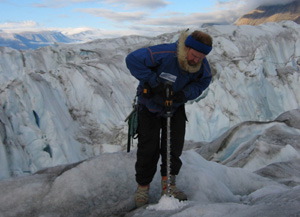
My daily duties on board the ship have been to be on Watch twice daily for 4 hours, maintenance to the ship's equipment and field training and logistics support for the science programs. I have been training some crew in glacier travel, safety in the field and Greenlandic customs and way of life up here.
The past two days we were at anchor at the end of Scoresby Sound, the world's largest fjord (350km long) in a sheltered bay with icebergs drifting by, and high mountains (up to 1800 m) and glaciers drooping down off the distant ice cap. The lower land here has some green grass, flowers and shrubs, and musk oxen and arctic hare have been sighted nearby. The air temperature is about 5 degC, and today the wind was calm. The past few days there have been low clouds and fog, but that lifted yesterday to reveal these majestic peaks.
The past two days I have been assisting two glaciologists in surveying the velocity of the nearby Daugaard Jensen glacier. We have now left this site and are looking down the fjord to see if the weather will allow us to conduct further glaciology in Vestfjord, otherwise we will go on to the town of Ittoqortoormiit (Scoresbysund) to visit the locals, catch up with friends and interview some of the elder hunters etc about what they've witnessed with regards to climate change. We have quite a few adventures in store the next two months. We hope to head north toward Zackenburg arctic research station in Greenland's national park (the world's largest) and then head south around southern Greenland and visit some towns and glacial areas on Greenland's west coast. I'm sure I will have plenty to talk about once I return to Australia in September.
June 27, Grand Marais, Minn.
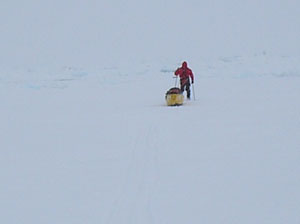
Though the expedition was unsuccessful in dealing with the ocean conditions off the Russian coastline, it was successful in reaching our main goal of bringng attention to Global Warming issue.
With figures still coming in, the One World Expedition garnered tens if not hundreds of millions of media impressions worldwide on Global Warming. A more precise number and list of media will be available in the next few weeks. We along with Geenpeace, our environmental and communication partner, will continue our campaign to fight global warming and bring you more updates from the ice through our 2006 Oceans project.
June 22, Grand Marais
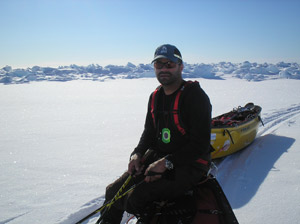
Life does not stop for very long. In Grand Marais, we are already busy with planning and preparation for the summer of 2006 - One World Expedition, the next step. Please keep posted for more exciting information on this upcoming expedition.
In the mean time, we are both keeping busy with preparations and planning. Lonnie has been working with images from the expedition and contacting sponsors and doing research for next summer. I am escaping for the moment and riding my bike around Lake Superior. I hope to make the entire 1300 miles in a little over a week. That means, riding around 150 miles a day.
Stay tuned for more biking, polar and Grand Marais news!
June 15, Grand Marais
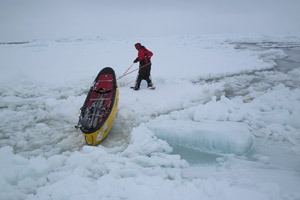
You are probably wondering what it was like out there on the Arctic Ocean so far away. We would like to share some of our experiences with you so that you can better understand the conditions that we faced.
Leads were always difficult to cross. They also changed in character throughout the trip and the day. Intially, we had to cross leads that looked a lot like this picture. They were full of brash ice and many times we had to jump from ice chunk to ice chunk just to get across. Of course, this would also make the ice unstable for the second person which would compound the problems even more.
One day we paddled across lead after lead after lead. It was fun paddling the boats because we actually made good time on the water. The stressful part was finding a good landing spot and hauling the boats up and out.
Later in the trip we even had one glorious day where we didn't have to get in our boats to cross large leads. We simply skied back and forth and found a narrow spot. Of course, this was only one day and the next day we were
back to our old arduous routine.
